Meteor showers have long captivated the curiosity of astronomers and stargazers alike, as these celestial spectacles paint the night sky with a breathtaking display of shooting stars. But have you ever wondered what causes these meteor showers? Here, we delve into the fascinating world of comets and asteroids, exploring their role in the creation of these mesmerizing events. Join us on this cosmic journey as we uncover the intricacies of celestial bodies, their relationship to meteor showers, and the significance of studying these astronomical wonders.
Contents
- Definition: What are Comets and Asteroids?
- The Origin of Meteor Showers
- The Relationship between Comets, Asteroids, and Meteor Showers
- The Role of Comets in Meteor Showers
- Asteroids and Meteor Showers
- Observing and Enjoying Meteor Showers
- The Significance of Studying Meteor Showers
- Conclusion
-
Frequently Asked Questions
- 1. What is the difference between a comet and an asteroid?
- 2. Where do comets and asteroids come from?
- 3. Do comets and asteroids have different shapes?
- 4. Can comets or asteroids collide with Earth?
- 5. Are there any famous comets that have been observed throughout history?
- 6. Are all asteroids located in the asteroid belt?
- 7. Can comets or asteroids be used as resources?
- 8. Do comets and asteroids pose any threats to Earth?
- 9. Can comets or asteroids reveal clues about the early history of the solar system?
- 10. Are there any missions planned to study comets or asteroids?
- References
-
Frequently Asked Questions
- 1. How do comets and asteroids contribute to meteor showers?
- 2. What is the difference between comets and asteroids?
- 3. How do comets create meteor showers?
- 4. Are all meteor showers associated with comets?
- 5. What are the characteristics of a comet’s tail?
- 6. How do asteroid dust trails contribute to meteor showers?
- 7. Which meteor shower is known for being an annual gift from a comet?
- 8. Can asteroids also produce meteor showers?
- 9. What are ideal viewing conditions for observing meteor showers?
- 10. Are there any annual events where meteor showers are celebrated?
- References
- Read More
Definition: What are Comets and Asteroids?
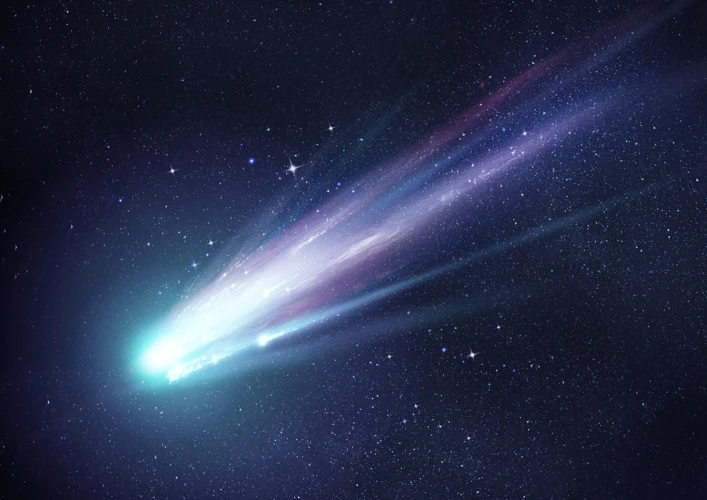
Comets and asteroids are two types of celestial objects that exist within our solar system. Comets are often referred to as “dirty snowballs” due to their composition of ice, dust, and rocky material. They typically have a nucleus, which is a solid core made up of ice and dust, surrounded by a glowing coma and sometimes a tail that is formed when the comet comes close to the Sun. Comets are believed to originate from the outer regions of the solar system, primarily the Kuiper Belt and the Oort Cloud. They follow highly elliptical orbits and can take hundreds or even thousands of years to complete a single revolution around the Sun.
Asteroids, on the other hand, are rocky or metallic objects that are smaller than planets but larger than meteoroids. They are remnants from the early formation of the solar system, often referred to as “minor planets.” Unlike comets, asteroids do not have a coma or a tail. They are primarily found in the asteroid belt, a region located between the orbits of Mars and Jupiter. However, asteroids can also be found in other locations, such as near-Earth orbits and even within the outer regions of the solar system. Some asteroids are thought to be fragments from larger bodies that were shattered through collisions or other catastrophic events.
While both comets and asteroids are fascinating objects in their own right, their distinctive characteristics and origins set them apart. Comets are known for their icy compositions and their ability to create tails when they interact with the Sun’s heat and radiation. Asteroids, on the other hand, are primarily rocky and metallic, lacking the volatile substances that comets possess. Understanding the nature of comets and asteroids is crucial for unraveling the mysteries of our solar system and the universe beyond.
The Origin of Meteor Showers
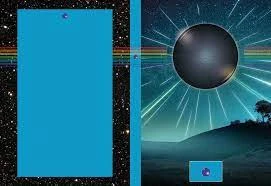
Meteor showers are a breathtaking phenomenon that occurs when Earth’s atmosphere intersects with the debris left behind by comets and asteroids. The origin of meteor showers can be traced back to the remnants of these celestial objects. When a comet approaches the Sun, its icy nucleus starts to heat up, causing the ice to vaporize and release dust and debris into space. This released material forms a trail along the comet’s orbit, known as the dust trail. As Earth orbits the Sun, it sometimes crosses paths with these dust trails, and as the particles enter our atmosphere, they burn up due to friction with the air’s molecules, creating the dazzling streaks of light that we observe as meteors.
Asteroids, although not as abundant as comets, can also contribute to meteor showers. When an asteroid collides with another celestial body or is subjected to the gravitational pull of larger objects, it can break apart, creating a field of debris in space. As with comets, when Earth encounters these debris fields, meteor showers occur.
Meteor showers are often associated with specific times of the year when Earth’s orbit aligns with the path of the debris left behind by a particular comet or asteroid. For example, the famous Perseid meteor shower occurs annually in August when the Earth passes through the debris trail left by the comet Swift-Tuttle. These regular events provide stargazers and astronomers with an opportunity to witness the beauty of shooting stars and study the composition and characteristics of these celestial remnants.
Understanding the origin of meteor showers not only adds to our knowledge of the cosmos but also helps us appreciate the interconnectedness between celestial bodies and our own planet. By studying meteor showers, scientists gain insights into the evolution of our solar system and the role that comets and asteroids play in shaping the world around us. Whether marveling at the Perseids or exploring the mythology of Ophiuchus, meteor showers are a testament to the awe-inspiring wonders of the universe.
The Relationship between Comets, Asteroids, and Meteor Showers
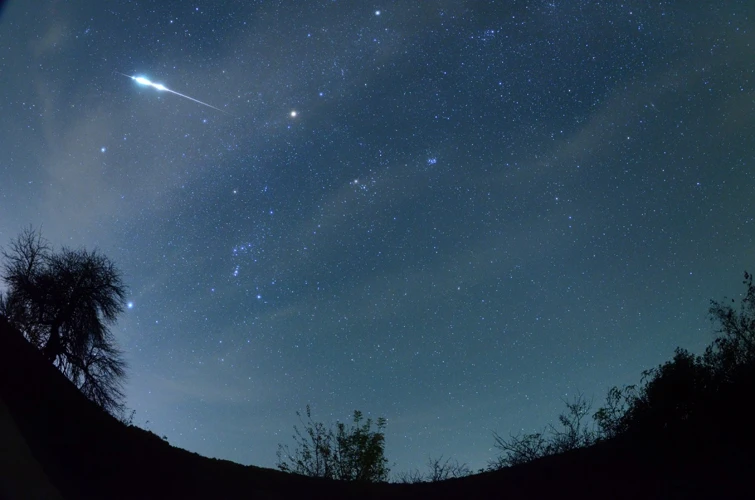
Comets, asteroids, and meteor showers are interconnected in a cosmic dance that showcases the dynamic nature of our solar system. While comets and asteroids originate from different regions of the solar system, they both play a vital role in the creation of meteor showers. Comets are often the main contributors to meteor showers. As they approach the Sun in their elliptical orbits, the intense heat causes the icy nucleus of the comet to vaporize, releasing dust and debris into space. This trail of particles left behind by the comet becomes the source material for a meteor shower when Earth passes through it. Asteroids also participate, albeit quietly, in meteor shower events. Some meteor showers are believed to originate from the dust trails left behind by asteroids as they travel along their orbits. These dust trails contain tiny meteoroids that collide with Earth’s atmosphere, resulting in the dazzling display of shooting stars. The relationship between comets, asteroids, and meteor showers highlights the interconnectedness of celestial objects and provides us with invaluable insights into the composition and history of our cosmic neighborhood.
1. Comets: The Main Contributors
Comets play a significant role in the creation of meteor showers and are considered the main contributors to these celestial events. Comets originate from the outer regions of the solar system and are composed of ice, dust, and rocky material. As a comet approaches the Sun, the heat causes the icy nucleus to vaporize, releasing gas and dust particles into space. These gas and dust particles form a coma, which is a glowing cloud around the nucleus, and often a tail that trails behind the comet.
During a meteor shower, Earth passes through the orbit of a comet, intersecting with the debris left behind by the comet’s previous visits to the inner solar system. This debris, also known as meteoroids, is made up of the gas and dust particles that were shed by the comet. As Earth encounters these meteoroids, they enter the atmosphere and burn up, creating the streaks of light that we see as meteors or shooting stars. The apparent origin point of the meteors, known as the radiant, is named after the constellation near which it appears in the sky.
Comets have long fascinated astronomers and have been linked to various cultural and mythological beliefs throughout human history. They have been regarded as omens of significant events or even celestial messengers. Exploring the mythology surrounding comets, such as the Ophiuchus mythology, can provide additional insights and context to our understanding of these celestial bodies.
The study of comets and their role in meteor showers is crucial for gaining a deeper understanding of the composition and evolution of the solar system. By analyzing the debris left by comets, scientists can learn more about the formation of planets, the distribution of elements and compounds within the solar system, and the potential for organic molecules that may have contributed to the origin of life on Earth. Comets truly are celestial wonders that continue to captivate our imagination and expand our knowledge of the universe.
2. Asteroids: Silent Participants
Asteroids: Silent Participants
Asteroids, though often overshadowed by their more glamorous celestial counterparts, play a significant role in the creation of meteor showers. While comets are the main contributors, asteroids act as silent participants in this cosmic phenomenon. Unlike comets, asteroids do not have a coma or a tail, making their presence less visually apparent during meteor showers. However, they contribute to the abundance of meteoroids that enter Earth’s atmosphere.
Asteroids are classified into different types based on their composition. These include carbonaceous (C-type), silicate (S-type), and metallic (M-type) asteroids, among others. Each type has its unique characteristics and composition, influencing the nature of the meteor showers they contribute to.
During a meteor shower, tiny particles, known as meteoroids, enter Earth’s atmosphere at high speeds and burn up upon friction with the air, creating the streaks of light we observe as shooting stars. Many of these meteoroids originate from asteroid remnants or fragments.
While comets primarily contribute to meteor showers through their icy composition and the debris they leave in their wake, asteroids serve as a constant source of meteoroids. The gravitational interactions between asteroids and other celestial objects can dislodge fragments and send them hurtling towards Earth. Additionally, asteroid collisions can create vast amounts of debris, which can gradually disperse and become part of meteoroid streams.
It’s worth mentioning that the timing and intensity of meteor showers associated with asteroids can vary. Some meteor showers have a consistent annual occurrence, such as the Perseids and the Geminids, which are known for their spectacular displays. These meteor showers are associated with known parent asteroids: the Perseids with Comet Swift-Tuttle and the Geminids with asteroid 3200 Phaethon. The gravitational influence of these parent bodies helps shape the meteoroid streams responsible for the meteor showers we observe.
While asteroids may be silent participants during meteor showers, they play a crucial role in supplying the steady stream of meteoroids that add to the spectacle. Their collisions, encounters with other celestial objects, and gravitational interactions contribute to the creation of meteoroid streams that result in the breathtaking meteor showers we enjoy. Understanding the involvement of asteroids in these celestial events deepens our knowledge of the vastness and interconnectedness of our universe.
The Role of Comets in Meteor Showers
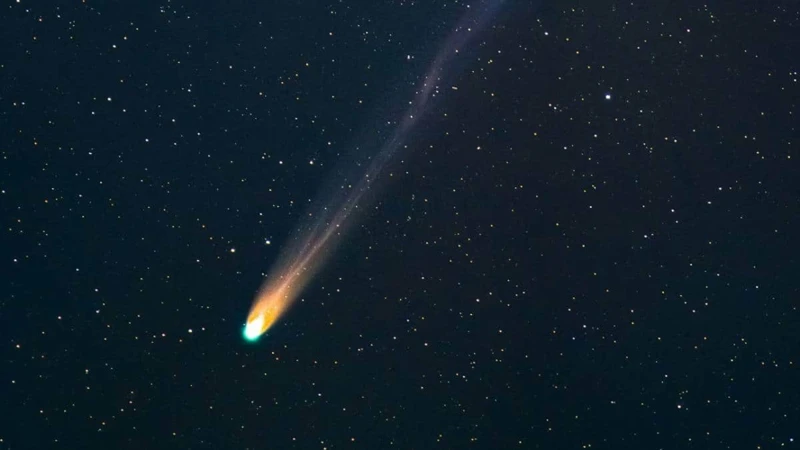
Comets play a significant role in the creation of meteor showers, contributing to the awe-inspiring celestial phenomena that often leave us spellbound. When comets come close to the Sun during their highly elliptical orbits, the intense heat causes the icy composition of the comet’s nucleus to vaporize, forming a glowing coma and a characteristic tail. As comets travel through space, they leave behind a trail of debris, consisting of dust and particles shed from their nucleus. When Earth passes through this debris trail, it interacts with our planet’s atmosphere, resulting in the dazzling display of meteors streaking across the sky. The famous Perseids meteor shower, for example, is directly linked to the debris left behind by the comet Swift-Tuttle. The role of comets in meteor showers is not just limited to their stunning visual impact; they are also a testament to the dynamic nature of our solar system and the delicate interplay between celestial bodies.
1. Comets and their Tails
Comets and their Tails
One of the most distinctive features of comets is their magnificent tails, which can extend for millions of kilometers into space. These tails are formed when a comet approaches the Sun and its icy nucleus begins to heat up. As the ice starts to vaporize, it releases gas and dust particles into space. The solar wind, a stream of charged particles emitted by the Sun, then blows these particles away from the comet’s nucleus, creating the tail that we see from Earth. The tail always points away from the direction of the Sun due to the pressure exerted by the solar wind. It is important to note that a comet can have two types of tails: the ion tail and the dust tail.
The ion tail is composed of highly charged gas particles that become ionized by the Sun’s energy. These ions are influenced by the Sun’s magnetic field, causing the tail to appear slightly curved. The ion tail is generally bluish in color and can be several million kilometers long. Observing the behavior of the ion tail can provide scientists with valuable insights into the magnetic fields and plasma environments around comets.
The dust tail, as the name suggests, is composed of tiny dust particles released from the comet’s nucleus. Unlike the ion tail, the dust tail does not respond to magnetic forces and therefore remains more straight and narrow. It often appears yellowish or reddish in color due to the scattering of sunlight by the dust particles. The dust tail can sometimes be fainter and less conspicuous than the ion tail, but it is still an important element in the overall visual spectacle of a comet.
Interestingly, the orientation and appearance of a comet’s tails can vary as it moves along its orbit. This is due to factors such as the angle at which the comet’s orbit intersects with Earth’s orbit, the relative motion between the comet and Earth, and the influence of solar wind. These variations can result in different tail lengths and angles, adding to the beauty and uniqueness of each comet’s display.
The study of comets and their remarkable tails not only deepens our understanding of the physical processes that occur in space but also provides insights into the composition and evolution of the comets themselves. Linking the behavior of comets and their tails to various planetary alignments and influences is an area of ongoing research, holding the potential for uncovering further connections between celestial phenomena and Earth’s energy systems.
2. Comet Fragments and Debris
Comet fragments and debris play a significant role in the formation of meteor showers. When a comet enters the inner regions of the solar system, the intense heat from the Sun causes the icy nucleus of the comet to vaporize, releasing gas and dust particles into space. These particles disperse along the comet’s orbit, creating a trail of debris. As the Earth orbits the Sun, it passes through these debris trails, resulting in meteor showers.
Comet fragments can range in size from tiny specks of dust to larger rocks. When these fragments collide with the Earth’s atmosphere, they heat up and burn, creating streaks of light that we see as meteors or shooting stars. The brightness and intensity of the meteors depend on the size and composition of the comet fragments. Smaller fragments produce quick and faint meteors, while larger fragments can create more spectacular fireballs.
The timing of meteor showers is often predictable as they occur when the Earth passes through the same region of the comet’s debris trail each year. For example, the annual Perseid meteor shower, which peaks in August, is caused by debris from the comet Swift-Tuttle. As the Earth moves through Swift-Tuttle’s orbit, it encounters the debris left behind by the comet, resulting in the stunning Perseid meteor shower.
Studying the composition and characteristics of comet fragments and debris provides valuable insights into the origins and evolution of comets. Scientists analyze the chemical composition and spectral signatures of meteoroids to understand the makeup of comets and the processes that occur within them. Additionally, studying meteor showers allows scientists to gather data about the structure and dynamics of Earth’s atmosphere.
Understanding the nature and behavior of comet fragments and debris is not only crucial for scientific research but also for appreciating the beauty and wonder of meteor showers. Observing these celestial events provides a glimpse into the cosmic dance between comets, asteroids, and our planet Earth.
3. Perseids: A Comet’s Annual Gift
The Perseids meteor shower is a spectacular celestial event that occurs annually, captivating skywatchers around the world. This meteor shower is named after the constellation Perseus, as the meteors appear to radiate from this area of the sky. But what is the connection between the Perseids and comets? Let’s take a closer look at this unique phenomenon.
The Perseids are actually associated with the comet Swift-Tuttle, which was discovered in 1862. This comet takes approximately 133 years to orbit the Sun, and its last appearance in the inner solar system was in 1992. The debris left behind by the comet during its journey consists of tiny particles called meteoroids. When the Earth passes through this cloud of particles in its orbit, they enter our atmosphere and burn up, creating the beautiful streaks of light that we witness as meteors.
The Perseids are particularly notable for their high meteor count and their vibrant, fast-moving meteors. At its peak, which usually occurs in mid-August, skywatchers can witness up to 100 meteors per hour. These meteors are often bright and leave long-lasting trails, adding to the spectacle. The Perseids have been observed for over 2,000 years, with records of the shower dating back to ancient Chinese, Japanese, and Korean observations.
This meteor shower occurs like clockwork every year because of the predictable nature of comet Swift-Tuttle’s orbit. As the Earth passes through the debris left behind by the comet, the particles collide with our atmosphere, resulting in the mesmerizing display of the Perseids. It’s truly a celestial gift from a comet that delights and inspires astronomers and stargazers alike.
Witnessing the Perseids can be a magical experience, and many enthusiasts plan their stargazing outings around the peak of this meteor shower. Whether you’re lying back on a blanket or camping out under the stars, the Perseids offer a captivating show that reminds us of the beauty and wonder of our universe. So mark your calendars and prepare to be dazzled by this annual gift from the comet Swift-Tuttle.
(Note: The Perseids meteor shower is just one example of a comet’s annual gift. Other meteor showers, such as the Orionids and the Geminids, are also associated with specific comets. However, for the purpose of this article, we’ll focus on the Perseids as a representative example.)
Asteroids and Meteor Showers
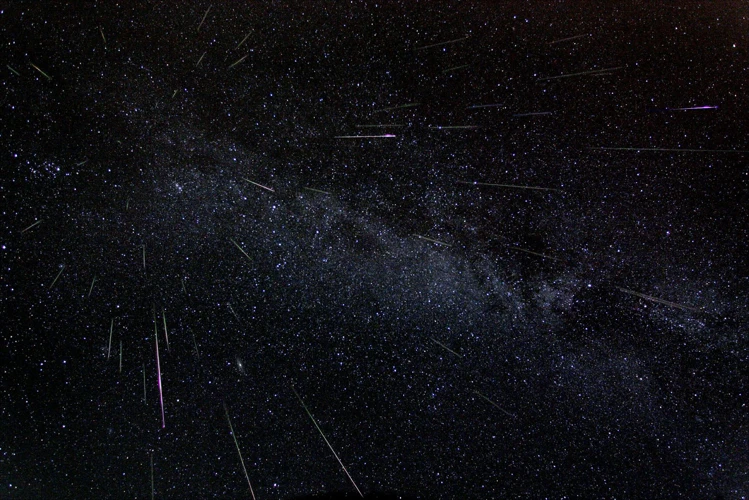
Asteroids play a significant role in the creation of meteor showers. These rocky objects, which orbit the Sun, are responsible for the majority of meteoroids that enter Earth’s atmosphere and create the dazzling display we know as meteor showers. Types of asteroids that are involved in meteor showers include Apollo, Aten, and Amor asteroids, which have orbits intersecting with Earth’s orbit. When Earth passes through these asteroid orbits, it encounters the debris left behind by the asteroids, known as meteoroids. The dust trails produced by asteroids are especially influential in creating meteor showers. These trails consist of fine particles that were ejected from asteroids due to collisions or other processes. When Earth passes through these trails, the meteoroids within them enter our atmosphere and burn up, creating streaks of light that we observe as meteors. One of the most famous meteor showers, the Geminids, is caused by debris from an asteroid named 3200 Phaethon. Studying the relationship between asteroids and meteor showers not only helps us understand the dynamics of our solar system but also aids in predicting and tracking potentially hazardous asteroids that could pose a threat to Earth in the future.
1. Types of Asteroids Involved
When it comes to the types of asteroids involved in meteor showers, there are several categories to consider. Primitive asteroids, also known as C-type asteroids, are the most common type and are made up of carbonaceous material. These asteroids are thought to be remnants from the outer regions of the solar system and contain a high percentage of water and organic compounds. Stony asteroids, or S-type asteroids, are composed of silicate materials and are the next most abundant type. They are believed to originate from the inner regions of the asteroid belt. Finally, Metallic asteroids, or M-type asteroids, are composed mostly of metals such as iron and nickel. They are thought to be fragments from the cores of differentiated parent bodies that were once larger asteroids.
These different types of asteroids play a role in meteor showers due to their interactions with Earth’s atmosphere. As they approach the Earth, they enter our planet’s gravitational field and begin to burn up, creating the stunning streaks of light that we observe as meteors. The composition of the asteroids determines the color and brightness of the meteors. For example, stony asteroids tend to produce brighter meteors, while metallic asteroids can create long-lasting and colorful trails. By studying the types of asteroids involved in meteor showers, scientists can gain insights into the composition and history of these celestial bodies, shedding light on the formation and evolution of our solar system.
2. Dust Trails and Meteoroids
Dust Trails and Meteoroids
Another way in which asteroids contribute to meteor showers is through the creation of dust trails and the production of meteoroids. As asteroids travel through space, they can shed debris and release small particles into their surroundings. These particles, known as meteoroids, can vary in size from tiny grains to larger chunks of rock.
When Earth passes through a dust trail left by an asteroid, the meteoroids within the trail encounter our planet’s atmosphere. As they enter the atmosphere, their high speed and friction with the air cause them to heat up and create what we see as shooting stars or meteors. The meteoroids burn up due to the intense heat, resulting in a brief streak of light across the sky.
The timing and intensity of meteor showers are influenced by the density and size of the meteoroid stream within the dust trail. Some meteor showers, like the Geminids, are associated with specific asteroid trails. The Geminids, for example, are caused by debris from the asteroid known as 3200 Phaethon. When Earth passes through the path of 3200 Phaethon’s debris, we are treated to a stunning display of shooting stars in December each year.
Studying the dust trails and meteoroids associated with asteroids provides valuable insights into the composition and behavior of these celestial objects. It also helps us better understand the dynamics of meteor showers and how they vary over time. By unraveling the mysteries of these cosmic phenomena, scientists gain a deeper understanding of our solar system and the celestial bodies that inhabit it.
3. The Geminids: A Stellar Display
The Geminids is a meteor shower that occurs annually in mid-December, making it one of the most eagerly awaited celestial events of the year. Named after the constellation Gemini, the radiant point from which the meteors appear to radiate, the Geminids provide a spectacular display of shooting stars. Unlike many other meteor showers, the Geminids are not associated with a comet but instead originate from an asteroid known as 3200 Phaethon. This unique characteristic sets the Geminids apart from other meteor showers as the debris and particles that create the meteors are believed to be the result of the asteroid’s orbit intersecting with Earth’s path around the Sun.
The Geminids are known for their high activity levels, often producing up to 120 meteors per hour during their peak. This makes them one of the most active and reliable meteor showers to observe. The shower’s radiant point lies in the constellation Gemini, but the meteors can be seen anywhere in the sky. Their bright and sometimes colorful streaks make them a visual treat for stargazers and astrophotographers alike. Due to their close association with Phaethon, the Geminids have a unique orbital pattern that brings them closer to Earth than most other meteor showers, resulting in brighter and more visible meteors.
The Geminids have been observed and documented since the 19th century, and each year, thousands of enthusiasts eagerly anticipate this stellar display. The shower typically peaks around December 13th or 14th, but the best time to observe the Geminids is during the late evening and early morning hours when the radiant point is highest in the sky. To maximize your viewing experience, find a location away from city lights, lie back, and let your eyes adjust to the darkness. Be patient and keep looking up, as the Geminids are known for producing frequent bursts of activity.
Witnessing the Geminids is not only a visual delight but also an opportunity to appreciate the wonders of our solar system. By understanding the origin and unique characteristics of this meteor shower, we gain a deeper insight into the role of asteroids in creating these captivating cosmic displays. The study of meteor showers like the Geminids allows us to unravel the mysteries of our celestial neighborhood and further explore the connections between asteroids, comets, and their impact on our Earthly environment. So, mark your calendars and be prepared to be dazzled by the remarkable spectacle of the Geminids meteor shower.
Observing and Enjoying Meteor Showers
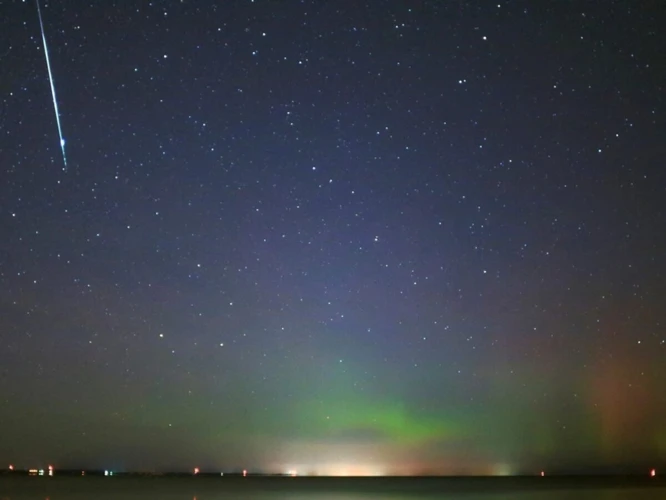
Observing and enjoying meteor showers is an awe-inspiring experience that allows us to witness the beauty of celestial events. To make the most of this celestial spectacle, it is important to be aware of the ideal viewing conditions. Clear, dark skies away from light pollution are ideal for observing meteor showers. Find a location that offers a wide, unobstructed view of the sky. Additionally, timing is crucial as meteor showers have peak periods when the highest number of meteors can be seen. It is recommended to check the meteor shower calendar to plan your observation. When observing, lie flat on your back and allow your eyes to adjust to the darkness. Patience is key, as it may take some time for your eyes to adapt and for meteors to streak across the sky. Remember to dress warmly and bring a comfortable chair or blanket. So, grab a hot beverage, gather some friends or family, and immerse yourself in the celestial show that meteor showers offer – a reminder of the vastness and beauty of the universe.
1. Ideal Viewing Conditions
When it comes to observing meteor showers, having ideal viewing conditions is essential for a memorable experience. Here are some factors to consider for optimal viewing:
Dark Sky: Find a location away from city lights and light pollution. The darker the sky, the better the visibility of meteors streaking across the sky.
Clear Weather: Check the weather forecast to ensure clear skies. Cloud cover can obstruct the view, impeding the visibility of meteors.
New Moon Phase: Aim to observe meteor showers during the new moon phase when the sky is at its darkest. This allows for maximum contrast between the meteors and the background sky.
Timing: Meteor showers have peak activity periods. Research and find out the best time to observe the particular meteor shower you are interested in. Some showers may have increased activity before dawn, while others may be more visible later in the evening.
Patience: Meteor showers can have varying levels of activity. Be prepared to spend a considerable amount of time outside, as it may take some time to spot the streaks of light. Bring comfortable seating and warm clothing to ensure your comfort while waiting.
By considering these ideal viewing conditions, you can enhance your chances of witnessing a spectacular meteor shower. Keep in mind that nature can sometimes be unpredictable, so even with optimal conditions, results may vary. So, find a suitable location, prepare yourself for a mesmerizing celestial show, and keep your eyes to the sky.
2. Tips for Observation
When it comes to observing meteor showers, there are several tips that can enhance your experience and increase your chances of seeing these cosmic wonders. Tip #1: Find a location away from city lights and light pollution. The darker the sky, the better your chances of spotting meteors. Tip #2: Be patient and give yourself ample time for observation. Meteor showers can have peaks and lulls, so it’s important to stay dedicated and remain watchful. Tip #3: Bring a comfortable chair or blanket to sit or lie down on. Observing meteor showers can require long periods of staring at the sky, so make sure to be as comfortable as possible. Tip #4: Keep yourself warm by dressing in layers, as nights can get chilly even during warmer months. Tip #5: Avoid using binoculars or a telescope, as these instruments limit your field of view. The naked eye is the best tool for observing meteor showers. Tip #6: Bring along snacks and beverages to stay hydrated and energized during your stargazing session. Tip #7: Stay updated on meteor shower forecasts and peak activity times so you can plan your observation accordingly. Websites and mobile apps dedicated to astronomy can provide valuable information on upcoming meteor showers and their estimated intensity. By following these tips, you can optimize your meteor shower viewing experience and fully immerse yourself in the marvels of the night sky.
3. Meteor Shower Events
Meteor Shower events are highly anticipated celestial phenomena that attract both amateur and professional astronomers. These events occur when the Earth passes through the debris left behind by comets or asteroids in its orbit around the Sun. During these events, the Earth’s atmosphere collides with the tiny particles, known as meteoroids, causing them to burn up and create streaks of light in the night sky.
Meteor shower events are often named after the constellation from which the meteors appear to radiate. For example, the Perseids meteor shower appears to originate from the constellation Perseus. The timing of meteor showers can be predicted based on the Earth’s annual journey around the Sun and the known orbits of comets or asteroids. These predictable events allow astronomers to plan observations and enthusiasts to enjoy the stunning display of shooting stars.
To fully appreciate meteor shower events, it is important to find an ideal viewing location away from light pollution. The darkness of the night sky allows for better visibility of the fainter meteors. Additionally, it is recommended to bring blankets or chairs for comfortable seating and to give your eyes time to adjust to the darkness.
While some meteor showers occur annually and are well-known, others are less predictable and can produce unexpected surges in activity. The Lyrids meteor shower, for example, is known for its sporadic outbursts where the number of meteors visible per hour can dramatically increase. These unpredicted displays add an element of excitement and surprise to the world of meteor shower events.
Observing meteor shower events provides invaluable opportunities for scientific research, as well. Astronomers can study the composition and characteristics of the incoming meteoroids to gain insights into the nature of comets, asteroids, and the early solar system. Understanding the patterns and behavior of meteor showers can provide crucial information about the composition and dynamics of our own planet.
So, whether you are an aspiring astronomer or simply a lover of the mysteries of the night sky, meteor shower events offer a captivating and awe-inspiring experience that connects us to the vastness of the universe. So, be sure to mark your calendars and find the perfect spot to witness these celestial fireworks firsthand.
The Significance of Studying Meteor Showers
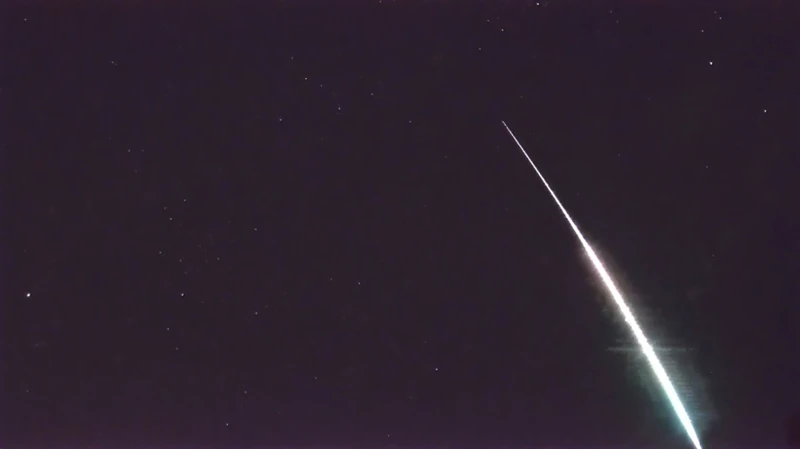
The study of meteor showers holds great significance in the field of astronomy and beyond. These celestial events provide valuable insights into the composition, behavior, and origins of comets, asteroids, and other celestial bodies. By studying meteor showers, scientists can gain a better understanding of the early solar system and how it evolved over time. Meteor showers also contribute to our understanding of the Earth’s atmosphere and its interaction with space debris, as meteors burn up upon entering the Earth’s atmosphere, leaving behind a trail of ionized gas. This ionization process can be studied to analyze atmospheric conditions and better comprehend the dynamics of our planet. Additionally, meteor showers have cultural and historical significance, as they played a role in shaping ancient civilizations’ beliefs and mythologies. By investigating meteor showers, we can connect with the past and explore the influence of cosmic events on human culture and society. The study of meteor showers, therefore, encompasses scientific, environmental, and cultural aspects, making it a multidisciplinary field of research with far-reaching implications for our understanding of the universe and our place within it.
Conclusion
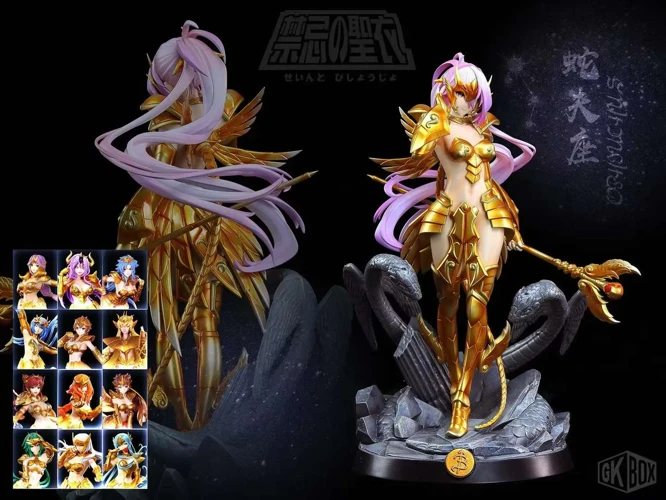
In conclusion, comets and asteroids play significant roles in the creation and spectacle of meteor showers. Comets, with their icy compositions and distinct tails, are the primary contributors to these celestial displays. As they journey closer to the Sun, the heat and radiation cause the icy nucleus to vaporize, releasing dust and gas that form glowing comas and tails. The annual Perseid meteor shower, for example, occurs when Earth passes through the trail of debris left by the comet Swift-Tuttle and treats sky gazers to a stunning show of shooting stars.
Asteroids, although not as prominent as comets in meteor showers, also have a role to play. Dust trails created by the disintegration or collisions of asteroids can give rise to smaller meteor showers. The Geminids, one of the most reliable meteor showers, is believed to be associated with the asteroid 3200 Phaethon. The debris left by this asteroid creates a radiant display in the night sky every December.
Studying meteor showers and their connection to comets and asteroids provides valuable insights into the formation and evolution of our solar system. It allows scientists to better understand the composition and dynamics of these celestial objects. Furthermore, meteor showers have inspired awe and wonder in humans throughout history, making them culturally significant as well. By unraveling the mysteries of meteor showers, we deepen our knowledge of the cosmos and gain a greater appreciation for the beauty of our universe.
Overall, the fascinating interplay between comets, asteroids, and meteor showers continues to captivate astronomers and stargazers alike. As we look to the skies and witness the celestial ballet of shooting stars, we are reminded of the vastness and wonder of our cosmos, and our place within it.
Frequently Asked Questions

1. What is the difference between a comet and an asteroid?
A comet is composed of ice, dust, and rocky material, while an asteroid is primarily made up of rock and metal.
2. Where do comets and asteroids come from?
Comets are believed to originate from the outer regions of the solar system, such as the Kuiper Belt and the Oort Cloud. Asteroids are commonly found in the asteroid belt located between the orbits of Mars and Jupiter.
3. Do comets and asteroids have different shapes?
Yes, they do. Comets often have a distinct nucleus surrounded by a glowing coma and a tail when they approach the Sun. Asteroids, on the other hand, have irregular shapes and do not possess a coma or a tail.
4. Can comets or asteroids collide with Earth?
Yes, both comets and asteroids can potentially collide with Earth. However, the likelihood of such an event occurring depends on various factors, including the size and trajectory of the object.
5. Are there any famous comets that have been observed throughout history?
Yes, some famous comets include Halley’s Comet, which is visible from Earth approximately every 76 years, and Comet Hale-Bopp, which was widely observed in 1997.
6. Are all asteroids located in the asteroid belt?
No, while the majority of asteroids are found in the asteroid belt, some can also be found in other locations such as near-Earth orbits or the outer regions of the solar system.
7. Can comets or asteroids be used as resources?
Yes, both comets and asteroids have been proposed as potential sources of valuable resources such as water, metals, and minerals, which could potentially be extracted for future space missions or colonization efforts.
8. Do comets and asteroids pose any threats to Earth?
Although the risk is relatively low, certain comets and asteroids have the potential to impact Earth, causing significant damage. Scientists and astronomers actively monitor near-Earth objects to assess any potential threats and develop strategies for planetary defense.
9. Can comets or asteroids reveal clues about the early history of the solar system?
Yes, comets and asteroids are considered time capsules that preserve valuable information about the conditions and composition of the early solar system. Studying these objects provides insights into the formation and evolution of our cosmic neighborhood.
10. Are there any missions planned to study comets or asteroids?
Yes, there have been numerous missions conducted and planned to study comets and asteroids. Some notable missions include the Rosetta mission, which successfully landed a probe on a comet, and the OSIRIS-REx mission, which is set to bring back a sample from an asteroid.
References
- The difference between asteroids and comets
- Meteor, asteroid and comet: What’s the difference?
- Asteroids, Comets & Meteors
Frequently Asked Questions

1. How do comets and asteroids contribute to meteor showers?
Comets and asteroids play a crucial role in meteor showers. Comets, with their tails and fragments, are the main contributors, while asteroids silently participate by creating dust trails and releasing meteoroids.
2. What is the difference between comets and asteroids?
Comets are icy bodies that originate from the outer reaches of the solar system and often have highly elliptical orbits. On the other hand, asteroids are rocky objects that primarily inhabit the asteroid belt between Mars and Jupiter.
3. How do comets create meteor showers?
Comets create meteor showers when their orbits intersect with the Earth’s path around the Sun. As they approach the Sun, the heat causes the ice in comets to vaporize, releasing debris and creating a trail of dust and gas along their path.
4. Are all meteor showers associated with comets?
No, not all meteor showers are associated with comets. While comets are the main source, there are also meteor showers linked to specific asteroids.
5. What are the characteristics of a comet’s tail?
A comet’s tail is composed of dust and gas that gets ionized by the Sun’s radiation. It typically points away from the Sun due to the solar wind, creating a beautiful and glowing trail visible during a meteor shower.
6. How do asteroid dust trails contribute to meteor showers?
Asteroid dust trails are created when asteroids cross the Earth’s orbit, leaving behind a trail of dust and debris. When the Earth passes through these trails, the particles burn up in the atmosphere, creating meteor showers.
7. Which meteor shower is known for being an annual gift from a comet?
The Perseids meteor shower is a well-known annual gift from the comet Swift-Tuttle. Every year in August, Earth passes through the debris left by the comet, resulting in a spectacular display of shooting stars.
8. Can asteroids also produce meteor showers?
Yes, asteroids can also produce meteor showers. The most famous example is the Geminids meteor shower, which originates from an asteroid called 3200 Phaethon.
9. What are ideal viewing conditions for observing meteor showers?
Ideal viewing conditions for observing meteor showers include finding a dark location away from city lights, choosing a clear night with minimal cloud cover, and allowing your eyes to adjust to the darkness for at least 20 minutes.
10. Are there any annual events where meteor showers are celebrated?
Yes, meteor showers are celebrated during various annual events such as the International Meteor Shower Night or the National Astronomy Week. These events bring together astronomy enthusiasts to enjoy the spectacle of meteor showers.
References
- Asteroids, Comets & Meteors: Facts
- Comets, meteors and asteroids
- Asteroids, Comets, Meteors, and Meteorites







